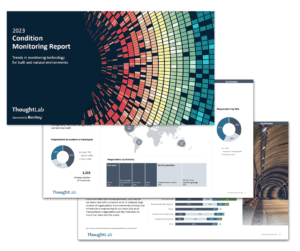Infrastructure Outlook: Real-Time Continuous Condition Monitoring Drives Safety and Environmental Integrity

 Companies that build, operate or service large infrastructure installations such as dams, mines and transportation facilities must monitor the conditions within—and surrounding—those installations to look for signs of possible structural degradation or environmental impact. In today’s world, where regulators and the public are paying closer attention to public safety and the environment, it’s becoming critical for organizations to automate the measurement of a growing range of parameters—in real-time and remotely. Failure to do so can lead to significant risks.
Companies that build, operate or service large infrastructure installations such as dams, mines and transportation facilities must monitor the conditions within—and surrounding—those installations to look for signs of possible structural degradation or environmental impact. In today’s world, where regulators and the public are paying closer attention to public safety and the environment, it’s becoming critical for organizations to automate the measurement of a growing range of parameters—in real-time and remotely. Failure to do so can lead to significant risks.
To understand current and future trends in condition monitoring and changing industry practices, Bentley Systems and ThoughtLab surveyed senior executives and technical staff at 500 companies of different sizes across six industry sectors and five countries. The study, conducted in the first quarter of 2023 and published in the “2023 Condition Monitoring Report,” revealed that companies are fast-tracking their shift from manual to automated condition monitoring. On average, two-thirds of condition monitoring is at least partially automated; in two years, that percentage will jump to 75 percent.
Making the Switch
Switching from manual to automated monitoring isn’t purely about responding to stakeholder and regulatory demands. It also can bring significant cost-benefits and improved return on investment. Interestingly, there’s little difference in cost between manual and automated monitoring. Approximately 16 percent of organizations today that haven’t yet moved to automated monitoring believe it’s more expensive than manual. In fact, after the initial costs of investing in automated systems are covered, the running costs typically are lower than the time-consuming manual approach.
When evaluating costs, many organizations don’t consider the strategic and soft benefits of an automated approach, including (potentially catastrophic) losses from lawsuits, fines and drops in stock prices that stem from oversights by manual monitoring. But making the switch can result in significant cost benefits and improved return on investment.
A case in point is the New Bullards Bar Dam. Managed by the Yuba Water Agency in Marysville, Calif., this imposing concrete-arch dam stands at 645 feet high and is situated along the North Yuba River, adjacent to the Tahoe National Forest. Constructed in 1969, its primary purposes encompass mitigating flood risks, generating clean hydroelectric power and ensuring a consistent water supply for nearby communities.
Until recently, the dam had been equipped with an outdated system that not only presented safety risks for personnel accessing the site, but also possessed a scarcity of survey points, rendering its condition incapable of being effectively monitored.
In late 2022, the Yuba Water Agency embarked on a digital transformation to revolutionize the collection of monitoring data, improve alerting capabilities and automate reporting mechanisms using digital twin technology.
The returns for the agency were profound, encompassing a substantial reduction in risk exposure and an improvement of safety standards. Moreover, the implementation yielded a marked decrease in downtimes and failures, subsequently leading to increased operational efficiency. One of the most striking advantages was the exponential augmentation in monitoring data points. In comparison to previous manual methods, the digital twin strategy facilitated an astonishing 1,000-fold increase in data points. This influx of data not only provided a more-comprehensive understanding of the dam’s behavior, but also empowered proactive decision-making. In addition, the automated survey system emerged as a game-changer, offering a 50-percent enhancement in data accuracy compared to previous collection techniques.
Mitigating Risk
Automated monitoring facilitates decision-making by engineers to operations managers to C-level executives, who can collectively see the whole picture before making a call. Condition monitoring is all about identifying risks you’re not comfortable with, quantitatively measuring that risk and making efforts to reduce it.
These risks can be very real for businesses. As the legal and political environment moves toward increased compliance, oversight and enforcement, undetected pollution can lead to fines and lawsuits as well as temporary or permanent plant shutdowns, impacts on brand reputation and loss of government contracts. In many countries, executive officers can be exposed to personal fines or jail. And structural weaknesses in infrastructure such as dams, mines or bridges could result in property damage, injuries or loss of life.
Currently, 19 percent of the organizations surveyed are fully automated, doing no manual monitoring; while 60 percent do partly automated monitoring; and 21 percent are mostly manual. Fully automated organizations on average track more than seven observable metrics, (e.g., air and water quality, power consumption, flow rates, tank levels or structural strain and deformation) vs. less than five for those relying on manual processes.
Getting Greater Value From Data
For condition monitoring, most organizations make extensive use of generic software tools such as Excel, Tableau and PowerBI, but these can’t manage data acquisition from devices and provide real-time alerts. They also rely heavily on manual data entry, which can be time-intensive, costly and prone to errors.
Nearly half of fully automated organizations (49 percent) integrate condition monitoring data with “digital twins,” which are virtual models of an asset and set of processes built from real-world data received from sensors or network-connected equipment. Digital twins offer the best way to combine disparate data from different sources into a single analytical platform. This enables data from condition monitoring to become meaningful and actionable.
A digital twin can become the broker among engineering, information and operational technologies—purpose-built for inputting all these datasets in one place for analysis. With condition monitoring, companies are measuring the physical world and converting it into digital form. Digital twins allow them to compare these observations against the model’s expectations.
A digital twin correlates condition data with other data and runs simulations to help companies understand deviations in trends. They feed that back into the decision-making and evaluation process, which is where the true value lies.
Overcoming Challenges
Although remote, automated and continuous is the ideal in condition monitoring, implementing it presents challenges for many organizations. These include lack of knowledge regarding the latest technological and IoT solutions, which still are evolving and may not be commercially available for some types of parameters.
While complete plug-and-play sensing solutions exist for many monitoring use cases, they’re not yet available for all, particularly when considering the need to work in a range of challenging environments. In some cases, companies need to source a variety of components that aren’t necessarily designed for continuous operation and remote management. That can require extensive solution engineering, including custom enclosures and protection measures, power systems and communication infrastructure.
Moreover, remote monitoring sensors and equipment often use different standards for transmitting data. They use various definitions, vocabulary, data storage and exchange formats, which may not be compatible with software that companies are using to process and analyze sensor data. Those responsible for environmental monitoring often don’t have the necessary skills to ensure that everything works seamlessly together.
To overcome these difficulties, organizations should consider partnering with specialist consultants or providers with the expertise to find, modify and install the proper sensing components. These partners also will have the skills to integrate different technologies and sensors for a particular sensing application. And they will be able to put together equipment from different manufacturers and ensure the telemetry from these disparate sensors can be transmitted to—and correctly interpreted by—a company’s data-management systems and software.
Ultimately, organizations will find that the benefits from and returns on remote, automated condition monitoring make it worth their while to surmount these difficulties and invest the necessary time and money. For companies that overcome these challenges, the rewards can be high, with some organizations citing returns of $1 million or more.
Learn more about the latest trends in condition monitoring and how organizations are adopting automation in the “2023 Condition Monitoring Report.”
About Steve Bentley
Steve Bentley is senior director, Infrastructure IoT, Bentley Systems; email: [email protected].


